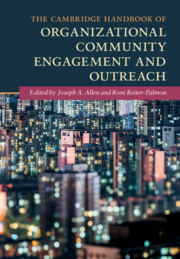Book contents
- The Cambridge Handbook of Organizational Community Engagement and Outreach
- The Cambridge Handbook of Organizational Community Engagement and Outreach
- Copyright page
- Dedication
- Contents
- Figures
- Tables
- Contributors
- Acknowledgments
- Part I Introduction: Organizational Community Engagement over Time
- Part II University–Community Partnerships
- Part III Disciplinary Outreach
- Part IV Interdisciplinary Outreach
- Part V Leading Community Engagement Efforts
- Part VI Putting It All Together
- Appendix A: Contributor Biographies
- Index
- References
Part VI - Putting It All Together
Published online by Cambridge University Press: 14 December 2018
- The Cambridge Handbook of Organizational Community Engagement and Outreach
- The Cambridge Handbook of Organizational Community Engagement and Outreach
- Copyright page
- Dedication
- Contents
- Figures
- Tables
- Contributors
- Acknowledgments
- Part I Introduction: Organizational Community Engagement over Time
- Part II University–Community Partnerships
- Part III Disciplinary Outreach
- Part IV Interdisciplinary Outreach
- Part V Leading Community Engagement Efforts
- Part VI Putting It All Together
- Appendix A: Contributor Biographies
- Index
- References
- Type
- Chapter
- Information
- Publisher: Cambridge University PressPrint publication year: 2019



